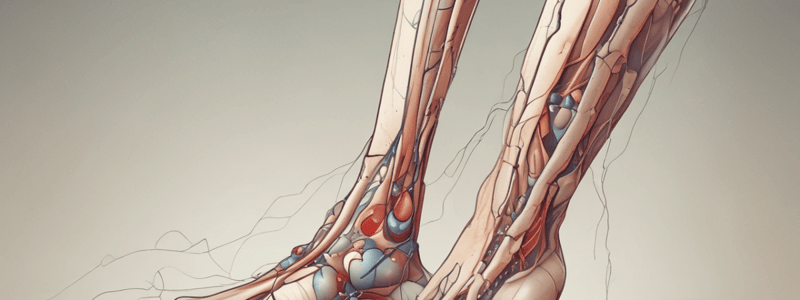Podcast
Questions and Answers
What is the term for division of the nerve by an open wound?
What is the term for division of the nerve by an open wound?
- Axontmesis
- Neurotmesis (correct)
- Wallarian degeneration
- Phagocytosis
What is the purpose of Tinel's sign in nerve injury diagnosis?
What is the purpose of Tinel's sign in nerve injury diagnosis?
- To assess muscle strength
- To diagnose nerve injury
- To monitor progressive recovery (correct)
- To detect nerve compression
What is the primary cause of femoral nerve injuries?
What is the primary cause of femoral nerve injuries?
- Gunshot wounds
- Traction during operation
- Hematoma formation
- All of the above (correct)
What is the typical presentation of sciatic nerve injuries?
What is the typical presentation of sciatic nerve injuries?
What is the primary treatment for open sciatic nerve lesions?
What is the primary treatment for open sciatic nerve lesions?
What is the characteristic sensory loss in peroneal nerve injuries?
What is the characteristic sensory loss in peroneal nerve injuries?
What is the typical cause of peroneal nerve injuries?
What is the typical cause of peroneal nerve injuries?
What is the term for the process by which damaged axons are resorbed?
What is the term for the process by which damaged axons are resorbed?
What is the prognosis for sciatic nerve injuries?
What is the prognosis for sciatic nerve injuries?
What is the term for the abnormal position of the foot in peroneal nerve injuries?
What is the term for the abnormal position of the foot in peroneal nerve injuries?
Flashcards are hidden until you start studying
Study Notes
Nerve Injuries in the Lower Limb
Neurotmesis
- Division of nerve by open wound, no recovery without surgical intervention
- Axons may fail to reach distal segment or target organ (neuroma)
- Healing occurs through disintegration and regeneration of axon
Clinical Features
- History of fracture, dislocation, or injury
- Numbness, weakness, and abnormal position (foot or wrist drop)
- Diagnosis:
- Tinel's sign for progressive recovery
- EMG and NCS
Femoral Nerve
- Injuries caused by gunshot, traction during operation, hematoma
- Clinical features: weakness of knee extension, depressed knee reflex, sensation problems in thigh and leg
- Treatment: early evacuation of hematoma, suturing or grafting of cut nerve
Sciatic Nerve
- Injuries caused by trauma, dislocation, gunshot, and iatrogenic accidents
- Clinical features: foot drop, numbness, paresthesia, and pain in leg and foot
- Treatment: reduction of dislocation, exploration in open lesions, splinting
- Prognosis: poor, late, and partial; tendon transfer or amputation may be necessary
Peroneal Nerve
- Causes: knee trauma, varus, splints, and slaps
- Clinical features: foot drop, eversion loss, leg and dorsum sensory loss
- First cleft sensation loss due to deep peroneal nerve
- Anterior compartment syndrome may cause deep peroneal nerve palsy
- Treatment: open lesion exploration, compartment syndrome release, splinting, and skin care
- Tendon transfer for disability
Studying That Suits You
Use AI to generate personalized quizzes and flashcards to suit your learning preferences.




